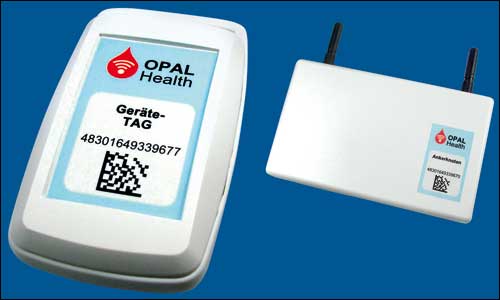Aug 17, 2009At Erlangen University Hospital, in Erlangen, Germany, a consortium that includes the Fraunhofer Institute for Integrated Circuits (Fraunhofer IIS) will soon carry out a six-month trial of a wireless sensor network developed to locate medical equipment and monitor the cold chain for blood.
Fraunhofer IIS' communication networks department developed the system as part of the so-called OPAL-Health project, which was partly sponsored by the German Federal Ministry of Economics and Technology's SimoBIT program. SimoBIT supports the development of secure mobile IT applications for midsize companies and public agencies.

The idea for the project first emerged during discussions held in 2006 between Fraunhofer IIS and industrial partner Delta T, which operates in the blood-transport sector. In mid-2006, all five project partners met to identify numerous manual processes in blood transport, as well as the tracking and locating of expensive medical equipment that is often the property of a single hospital division but shared by many. The partners designed the system to reduce manual-tracking processes for the machines, and to improve the efficiency of those processes.
If a patient is attached to a portable heart-monitoring device after surgery, for instance, that device—which is the property of the surgical division—is loaned out to the section of the hospital that operates the recovery room when a patient is moved from one area to another, says Ulli Münch, a staff member at the Fraunhofer IIS' Center for Intelligent Objects (ZIO), who is focusing on process optimization and IT integration in the OPAL Health project.
The surgical division, which must account for its expensive medical equipment, runs the risk that the heart-monitoring device might become misplaced within the hospital, or be stolen. To prevent both scenarios from occurring, OPAL-Health's partners sought to monitor the devices remotely. They considered passive RFID for the job, but ruled out that option since passive RFID tags are read only when excited by an interrogator, and the partners wanted constant monitoring. In addition, consortium members were concerned about potential interference that RFID transmissions may cause for sensitive medical equipment.
Another idea, Münch says, was to employ Wi-Fi tags in conjunction with WLAN technology. However, he adds, few hospitals in Germany are completely outfitted with the Wi-Fi networks. Ultimately, the partners ruled out Wi-Fi tags since they are too large and, due to WLAN standards, use substantial energy, thus leading to a considerably shorter operating life for the Wi-Fi tags.
The tags utilize Fraunhofer IIS' patented media-access protocol. The "Slotted MAC," as it's known, allows for energy-efficient and secure data communication. The tag's unique ID number, temperature and position information are passed along the network until reaching the hospital's clinical information system, which then uses the data to map the locations of tags and alert users if temperatures move outside of the desired, pre-set range.
At the end of 2007, the partners began working on their individual elements of the project. OPAL-Health is being led by IT services company T-Systems, which serves as the project's integrator and aims to commercialize the system once testing is complete. Fraunhofer IIS is in charge of developing software for the wireless sensor network, as well as the sensor tags. Friedrich-Alexander University Erlangen-Nuremberg is hosting the trial at its university hospital. Vierling Communications is developing and producing the hardware for the wireless sensor network. Delta-T is focused on the temperature surveillance of blood transported between clinics.
The planned six-month trial is designed to test the technology in a real-world scenario, as well as study its acceptance by hospital employees. OPAL Health's partners also want to learn if the technology actually helps the hospital become more efficient—that is, if the tags help workers locate equipment faster than in the past. Christian Flügel, who works for Fraunhofer IIS' communication networks department, says he expects the test to include 500 to 700 tags, deployed in multiple phases, including 200 to 300 on medical devices. The tags measure 4 centimeters (1.6 inches) in width by 6 centimeters (2.3 inches) in length, but Flügel expects that project partners can reduce their size after the completion of the field trial.
Employees working in the blood bank will also attach the tags to blood bags, and the tags' sensors will measure the blood's temperature every 10 minutes. This data will be moved throughout the network until it reaches the hospital's IT system. When bags are returned to the hospital's in-house blood bank, workers will remove the tags and reuse them on other bags. Patients who choose to participate in the trial—by wearing a smart-object wristband—will benefit from additional security at the time of a transfusion. The ID number of the tag attached to the intended blood bag will be matched to the patient's ID number, encoded to the tag attached to his or her bracelet, in order to ensure that a match ensues.
Additional applications are conceivable for hospitals, Münch says, based on the same hardware infrastructure, such as access-control systems or patient localization. The OPAL-Health network, he notes, is among the first such asset-monitoring application to employ wireless sensor networks operating at 868 MHz.


